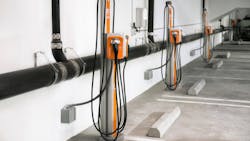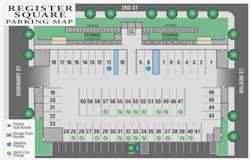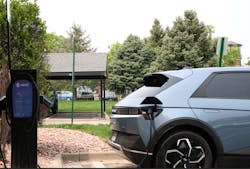Multifamily EV Charging: The Race to Serve the Market Is On!
According to BloombergNEF, we have reached a tipping point – more than half of all car sales in the United States will be electric by 2030. So, why is the multifamily housing market segment so important to mass electric vehicle (EV) adoption? Because a majority of charging happens at home, and according to the National Association of Home Builders, 44 million residences, or 31% of housing in the U.S. today, are multifamily housing.
As the paradigm of how we power our vehicles is transformed, charging where EV drivers dwell will be key to driving the electrification of transportation while reducing air pollution and helping us reach our carbon reduction goals.
Building Limitations, Multiple Stakeholders
Some of the reasons why EV charging at multifamily buildings lags behind single-family buildings have to do with the very fact that there are multiple stakeholders involved. This includes building owners and operators, condo owners and residents, HOAs, and increasingly, utilities. Service providers who successfully solve the multi-stakeholder multifamily EV charging puzzle can gain an early adopter advantage and capture a large market share.
While make-ready and building codes help with new construction, multifamily EV charging almost always involves a costly retrofit. For instance, according to a CalMatters report, 40% of multifamily parking spots in California need to be electrified. However, the current stock of multifamily buildings tends to have older technology and requires electrical service upgrades. Most properties are not outfitted for an L2 charging load, and the electrical service availability is often not there. And then there is the issue of how to split the service, provide metering for each unit, charge back tenants, and determine who is responsible for electric vehicle supply equipment (EVSE) uptime and maintenance.
“One of the biggest obstacles to deploying charging infrastructure at apartment complexes is simply the high cost of installation,” said Loren McDonald, CEO of EVAdoption, an EV and EV charging analyst firm. “Older apartment buildings (pre-90s) will typically need to upgrade electrical panels and potentially have additional power pulled from the utility. Depending on the situation, costs can range from $5,000 to $20,000 per Level 2 charging station.
“When you combine these relatively high costs with most owners/operators not even knowing how many of their tenants (or prospective tenants) drive EVs, the return on investment can be uncertain,” McDonald said. “Owners/operators must also balance investments in EV charging infrastructure that may only benefit a small percentage of tenants and for which the payback will be many years. Should an owner/operator invest in installing EV charging stations versus things like upgrading carpets, repairing the roof or pool, or adding an exercise room — things which benefit all tenants? Unless owners/operators partner with third-party charging deployment companies that take on the deployment costs and risk, the owners/operators will likely choose repairing the roof.”
While basic EVSE hardware starts at $300, it often does not include must-have applications such as smart features, dual ports, scheduling, load management and throttling, reporting, and analytics. According to EVAdoption, the cost per port ranged from a low of $6,205 to a high of $17,099 and averaged $9,808 for Level 2 deployments at a Northern California multifamily property. The percentage of project costs attributed to non-hardware aspects ranged widely but averaged 56.1% of total project costs.
So how do you provide EV charging when there is no parking available, say at a 100-unit building in the Bronx? Some options include electrifying light poles and bringing charging curbside. The good news is that big metro areas can better support a tenant community. This, in turn, attracts funding. Several states offer rebates and incentives to help offset the initial purchase of chargers as well as the cost of electrical upgrades, as they tend to be expensive and lengthy (especially if utility involvement is required).
Charging is also often relegated to areas in out-of-the-way places, such as behind dumpsters, due to charger size and aesthetics, and because that’s where power cabinets are located. This inadvertently creates safety issues for users (specifically at night). Another challenge is that parking garages were designed for ICE weight, which are lighter than battery electric vehicles (BEVs), which may pose structural challenges. There is also the challenge of chargers being down and not working (that’s where companies such as ChargerHelp! are leading the way).
Solutions for Multifamily EV Charging
Some of the companies who are trying to solve this issue include incumbents (Blink, ChargePoint, and Tesla), as well as a batch of new innovators, including Amperage Capital, EV Connect, EverCharge, Loop, Oodles Energy, Pangea Charging, SWTCH, Wevo Energy, and Xeal.
Wevo Energy, a 2021 Israel-based startup working on deployments in the New York tri-state area, provides a software platform to optimize EV charging and to solve the energy capacity issue. The company’s cloud-based platform enables charge point operators (CPOs) and building owners to easily and effectively manage EV charging at apartment complexes, workplaces, commercial properties, and destination charging applications. Using a patent-pending algorithm, data science, and artificial intelligence (AI), Wevo learns EV driver behavior to orchestrate the ideal charging schedule while minimizing electricity costs and taking advantage of available grid incentives.
Recently installed ChargePoint CPF50s at Register Square Napa, a new multifamily building in Napa, California.
Image Source: John Andrews, MBA, dipWSET
Wevo's load management technology maximizes existing building infrastructure by allocating power where and when it's needed most, allowing sites to install more charging stations without expensive (and often lengthy) infrastructure upgrades. According to Wevo, predictive load balancing (PLB) outperforms traditional load balancing by 2.5x, doubling EV capacity without increasing the grid connection or impacting the customer experience. Wevo utilizes behavioral economic incentives to encourage drivers to charge when rates are lowest and ensure that the vehicle is fully charged by the time it's needed for use. Their smart algorithms learn drivers' behaviors and create an optimal charging schedule.
"Apartment buildings have some unique challenges when it comes to EV charging installations, such as aging infrastructure and capacity constraints. Since most EV charging is done at home rather than at public charging stations, it is crucial to make EV charging scalable, efficient, and simple for multi-unit dwellings to help accelerate EV adoption," said Marina Hod, Wevo Energy Vice President of Strategy & Market Development.
Another startup, Amperage Capital, partners with asset owners that have more than $1 billion in assets under management and is solely focused on business models that have the potential to be cashflow positive in the future. If building owners want to have part of the upside beyond a simple revenue share, they can co-invest with Amperage, enabling them to provide an Internal Rate of Return (IRR) to their investors. Essentially, Amperage is an infrastructure fund, and because it operates as a fund, it can enable owners to provide investors with an IRR. They claim that the owner/operator can expect to receive an IRR of more than 18%.
Loop CEO, Dustin Cavanaugh, recently told Bloomberg Markets that building owners can “turn parking lots into revenue centers by offering EV charging services…the parking lot is already monetized, EV charging would simply add ancillary services.”
Amperage sees a pent-up demand, and they want to help residents/EV drivers, building owners, and investors collectively reap the benefits. An ROI for a deployment is a long game, with break-even on a $500 million investment requiring a 300-unit apartment building with a 5% EV adoption, or 15 EVs with a $75 subscription per month each. Portfolio companies need to see dwell time and high utilization. One such use case is fleet at home.
As initial capital outlay can be a significant hurdle, Amperage bears all upfront Capex costs that can be in the $500,000 range (breaker, transformer, EVSE, etc.) Also, soft costs, which include expenses like permitting, design, and installation labor, can have a significant impact on the viability of EV investments.
"By focusing on reducing soft costs, Amperage has made EV infrastructure installation financially viable, bringing the cost of installing a Level 2 charger below $5,000,” said Shannon Johnson, Amperage Capital Chief Investment Officer and Co-Founder. “This has allowed us to reach our targeted space strike price, benefiting both investors and tenants. Now, tenants can access power in their spaces by paying a small monthly connection fee, making EV charging accessible and affordable."
Currently, Amperage has two projects in development. They will provide access to charging for more than 5,000 apartments across 19 communities in tier 2 cities. They also have two DCFC charging projects in Dallas and Indiana.
Xeal Energy also sees EV charging as a new revenue stream for building owners. Xeal only sells and manages the equipment necessary for the building owner, and they want to solve the reliability issue. While Xeal does not finance or deploy Capex (electrical or otherwise), they help building owners highlight costs and guide them through the timing and process.
Xeal claims to have thousands of stations deployed in over 40 major markets. They utilize OCPP-compliant hardware and have partnered with a number of OEMs, most notably US-based EVSE provider Enphase, for a turnkey solution.
They have a unique decentralized approach – they don’t need connectivity to use and install EVSE, and building owners are not saddled with the need to upgrade software or firmware. Over the Air (OTA) updates come via the EV driver’s smartphone and are not connected to or dependent on the building. This is a huge advantage where communication is an issue.
1 of 16 Xeal chargers at Greystone-managed Lowry Park Apartment in Denver, Colorado.
Image Source: Xeal
Xeal believes that building owners/landlords will be able to own the “gas station of the future,” and it can be a profitable charging model. However, high utilization will be key to obtaining an ROI in 2 to 2.5 years and will be dependent on EV adoption and saturation. These new amenities can also attract new residents and accelerate the EV adoption curve.
"The largest driver for EV charging in multifamily will be the tenants’ leasing decisions. When landlords realize that they are losing to comparable buildings in the market because they don't have adequate charging, but their competition does - that's when the race will be on, and it will go from an attractive amenity to a necessity as important as air conditioning," said Eric Roseman, Chief Revenue Officer.
French EV charging firm Zeplug, with 30 U.S. employees, is coming off a recent $240 million investment from Britain's Intermediate Capital Group (ICG) and planning a U.S. expansion. They provide a hardware-agnostic L2 charging station that is also OCPP-compliant and offers load management features. They claim to have 70 units deployed, with 500 more being installed.
Zeplug shoulders the Capex and operational costs, including conduit, switchgear, EVSE, maintenance, and operation costs. The cost of electricity is based on a subscription for end-users only, with no cost to the building owner or HOA, clearing a significant hurdle. The end-user also pays for a software analytics package that building operators have access to. Zeplug looks at the building’s available capacity, then coordinates with utilities to upgrade the service if needed. They are also working with utilities on Time of Use (TOU) and rate plans.
Their main differentiator? Providing a charging as a service (CaaS) solution. This incentivizes Zeplug to fix assets so they are always working. Their ideal customer profile includes corporate, commercial office parks, and multifamily buildings. Buildings with high occupancy rates are their sweet spot. They are also looking for OEM partnerships (similar to WeaveGrid’s EV adoption approach).
Developers See an Opportunity
In their partnership with Amperage, JVM corporation, which operates a $1.6 billion multifamily portfolio in the greater Midwest, including Illinois, Indiana, Kansas, Missouri, and Wisconsin, is working on a scalable solution to be able to support current and future demand.
For their pilot portfolio, their current demand is charging for 24 EVs. They will be installing 43 charging stations and will retrofit 149 spaces to accommodate charging. By 2028, that number is projected to increase to 260 charging stations. Upon pilot completion, they plan to evaluate how this can be seamlessly integrated into a portfolio-wide rollout. The forecasted demand for JVM includes 19 properties in total, 4+ megawatts of power, and 30% of spaces that will be upgraded to provide EV charging.
“At JVM Realty, we are committed to meeting the needs of all stakeholders - investors, owners, employees, residents, and prospects alike,” said Steve Boyack, Chief Operating Officer at JVM Realty. “Our visionary approach integrates present and future requirements, staying attuned to the dynamic EV infrastructure landscape. This approach not only meets the current demand in the market but is designed to scale to a more EV-centric future. Instead of reacting, we proactively strategize, recognizing the transformative potential often overlooked due to uncertainty.”
“Our ambition extends beyond multifamily housing to bring EV charging to office and retail spaces. By converting parking lots into revenue centers, building owners enhance their value proposition with ancillary services. We believe in delivering on the ever-changing demands of our resident base. From the end-user perspective, this will allow individuals to go from home to the office to dinner without skipping a beat. As a result, this directly complements our 360-mobility strategy for all patrons across the residential, office, and retail components of our portfolio,” added Boyack.
StreetLights Residential develops, designs, and builds new apartment homes and mixed-use developments. They have more than 15,000 multifamily units completed, in progress, or in design in 19 cities across six states, and they are working with Xeal to bring charging to the multifamily space.
“EV charging has been in high demand recently,” said Jonathan Stephens, Director of Development at StreetLights Residential. “More and more of our residents are purchasing EVs, and, even if they don’t own EVs today, many are planning to purchase one over the next few years. In response to this, we have increased the minimum number of charging stations at our properties to better serve our residents. At The Hadley, a recently opened 300-unit property in Midtown Atlanta, we installed 30 Xeal charging stations to better meet the growing demand. This has given us a competitive advantage over other properties with fewer EV charging stations, and we’re happy that our residents will have readily available access to reliable and consistent charging. Currently, approximately 10% of the property’s residents own an EV – which tells us we are on the right track.”
Follow the Green Brick Road
Several other companies addressing the multifamily market include Qmerit, Oodles Energy, and Pangea Charging. While Oodles and Pangea have not announced any deployments or funding recently, Qmerit is actively promoting its network of licensed, nationwide electricians that install EV charging stations and provide other ancillary electrical services.
Working in an adjacent space, Logical Buildings has found a way to couple building owner and resident incentives for energy reduction and building electrification. WeaveGrid is working to match EV drivers with utilities to provide managed charging and integration of renewables to smooth out those pesky duck curves. As the EV charging market matures, some consolidation is inevitable. It’s possible that some of these issues will be resolved as companies join forces and consolidate their offerings.
More capital that can provide new ownership options and financing will be required to drive EVSE deployments. Creative solutions that combine incentives for residents as well as owners are also needed. Instead of purchasing carbon offset credits, large corporates could take on the Capex for buildings needed to help reduce or even eliminate the upfront costs of EV charging infrastructure and electrify previously underfunded communities. Local and state regulations will continue to be important levers, especially for renters. Many of the Right to Charge laws, which will require all parking spots at multifamily to be ready for EV charging stations to be installed, are rolling out in many states.
The addition of battery-integrated EV charging stations may be able to provide ancillary services for an entire building with power backup during blackouts.
It will take time before building owners and investors see EV charging as a revenue center, but if they don’t start now, their buildings will likely be less attractive to future tenants. As prices continue to come down for EVs, their sheer numbers will be a driver of charging. As of today, EV charging at multifamily residences very much feels like a luxury option.
About the Author
Joanna Hamblin
Joanna Hamblin specializes in developing integrated, creative, results-driven marketing and go-to-market strategies for leading cleantech, grid edge, EVSE (Electric Vehicle Supply Equipment) and eMobility companies.
Most recently Joanna led NAM eMobility Marketing for Schneider Electric, where she defined the application roadmap, marketing strategy and execution plan for a holistic, end-to-end hardware, software and app offering for residential, building and fleet segments. Prior, as a Sr. Marketing Manager at Motiv Power Systems, a sustainable technology company delivering all-electric medium-duty trucks and buses, she was responsible for all aspects of marketing. She also helped launch Motiv Energy, a one-stop-shop solution for fleets that delivered scalable charging infrastructure and asset monetization. Prior to joining Motiv, Joanna was the Head of Marketing at FreeWire Technology, a leading provider of battery-integrated DCFC (Direct Current Fast Charging) solutions for public and fleet segments. Preceding, Joanna was the Global Director of Marketing at Power Standards Lab, a leader in power quality and energy monitoring devices, a Marketing Manager at Gridco Systems, a DER (Distributed Energy Resources) integrator for electric power distribution utilities, and a Marketing Communications Manager at Ambient Corporation, a developer of smart grid communications infrastructure. Joanna holds a Master of Liberal Arts in Sustainability and Environmental Management, from Harvard University Extension School, and a Bachelor of Science in Business Administration in Finance from Northeastern University. Joanna is fluent in English and Polish.



